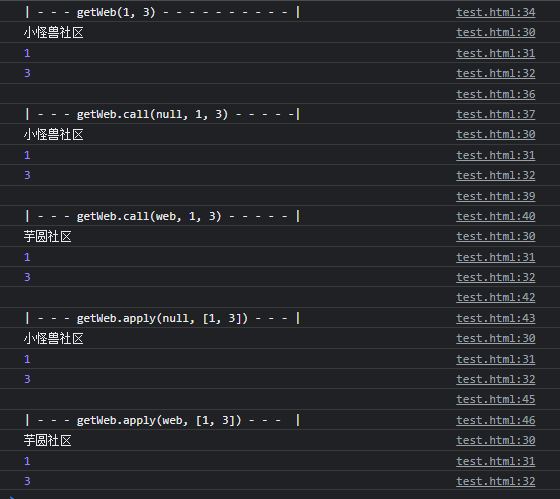call,apply,bind
1009
0
2022-08-01
2022-10-13
Hey、小怪兽
call()和apply()
- • 先看一个栗子:
-
var name = '小怪兽社区' var web = { name: '芋圆社区', } function getWeb() { console.log(this.name) } getWeb() // '小怪兽社区',全局对象 window里name变量 // 可以通过call和apply更改this的指向,获取web对象下的name getWeb.call(web) // '芋圆社区' getWeb.apply(web) // '芋圆社区' - • 从上可以看出call()和apply()可以改变this的指向,从全局变量的name改成了对象web的name
- • 它们的区别在于传递参数:
-
var name = '小怪兽社区' var web = { name: '芋圆社区', } function getWeb(num1, num2) { console.log(this.name) console.log(num1) console.log(num2) } getWeb(1, 3) // '小怪兽社区' 1 3 getWeb.call(null, 1, 3) // '小怪兽社区' 1 3 getWeb.call(web, 1, 3) // '芋圆社区' 1 3 getWeb.apply(null, [1, 3]) // '小怪兽社区' 1 3 getWeb.apply(web, [1, 3]) // '芋圆社区' 1 3 
- • 从上面代码可以看出:
- • call():
- - 调用call()的必须是个函数,getWeb()是个函数
- - call()的第一个参数是个对象,web就是个对象,如果不传对象就传null,默认选择全局对象window
- - call()从第二个参数开始,接受的是一个参数列表,会映射到函数的每一个参数上
-
// 指向全局变量window getWeb.call(null) // 接收到的参数是1, 2, 3 getWeb.call(obj, 1, 2, 3) - • apply():
- - 调用apply()的必须是个函数,getWeb()是个函数
- - 和call不同的是apply()只接收两个参数,第一个参数是个对象,web就是个对象,如果不传对象就传null,默认选择全局对象window
- - 第二个参数,必须是数组或者类数组,它们会被转换成类数组,会映射到函数的每一个参数上
-
// 指向全局变量window getWeb.apply(null) // 只接受到了参数1, 2 getWeb.apply(obj, [1, 2], 3) // 类数组,接受到的参数实际上是 1,2,3 func.apply(obj, { 0: 1, 1: 2, 2: 3, length: 3, }) - • apply()还可以用来取最大值最小值
-
// Math.max取最大值 Math.max(14, 3, 77); // ES5 的写法 Math.max.apply(null, [14, 3, 77]) // ES6 的写法 Math.max(...[14, 3, 77]) - • 自定义实现call():
-
Function.prototype.myCall = function(context) { context = context || window context.fn = this let args = [] for (let i = 1; i < arguments.length; i++) { args.push(`arguments[${i}]`) } // eval() 函数会将传入的字符串当做 JavaScript 代码进行执行。 let result = eval(`context.fn(${args})`) delete context.fn return result } - • 自定义实现apply():
-
Function.prototype.myApply = function(context, arr) { context = context || window context.fn = this let result if (!arr) { result = context.fn() } else { let args = [] for (let i = 0; i < arr.length; i++) { args.push(`arr[${i}]`) } result = eval(`context.fn(${args})`) } delete context.dn return result }
bind()
- • bind()函数和call(),apply()都是改变this的指向问题
- • 不同的是call(),apply()是临时指定this,而bind()则是返回绑定了指定this的新函数,也就是创建了一个函数,不管怎么调用这个函数,都有着相同的this
-
let obj = { name: '小白', } function getName() { console.log(this.name) } // bind返回了一个函数 let bindFn = getName.bind(obj) bindFn() // '小白' - • 传递参数:
-
let obj = { name: '芋圆社区', } function getValue(num1, num2) { console.log(this.name) console.log(num1) console.log(num2) } let bindFn = getValue.bind(obj, 1) bindFn(5) // '芋圆社区' 1 5 - • 自定义实现bind()函数:
-
Function.prototype.myBind = function(context) { let self = this // 获取myBind函数从第2个参数之后的参数(包含第二个参数) let args = Array.prototype.slice.call(arguments, 1) let result_f = function() { // 此时的arguments是指的myBind函数返回的函数传入的参数 let bindArgs = Array.prototype.slice.call(arguments) // 当作为构造函数时,this指向实例 // 当作为普通函数时,this指向window,将绑定函数的this指向context return self.apply(this instanceof result_f ? this : context, args.concat(bindArgs)) } // 修改返回函数的prototype为绑定函数的prototype // 下面三行的实现等同于 result_f.prototype = Object.create(this.prototype) let temp_f = function() {} temp_f.prototype = this.prototype result_f.prototype = new temp_f() return result_f } - • PS:自定义实现的都是从一个博客里记来的,忘记哪个博客了,到时候找到的话再标注
Message Board